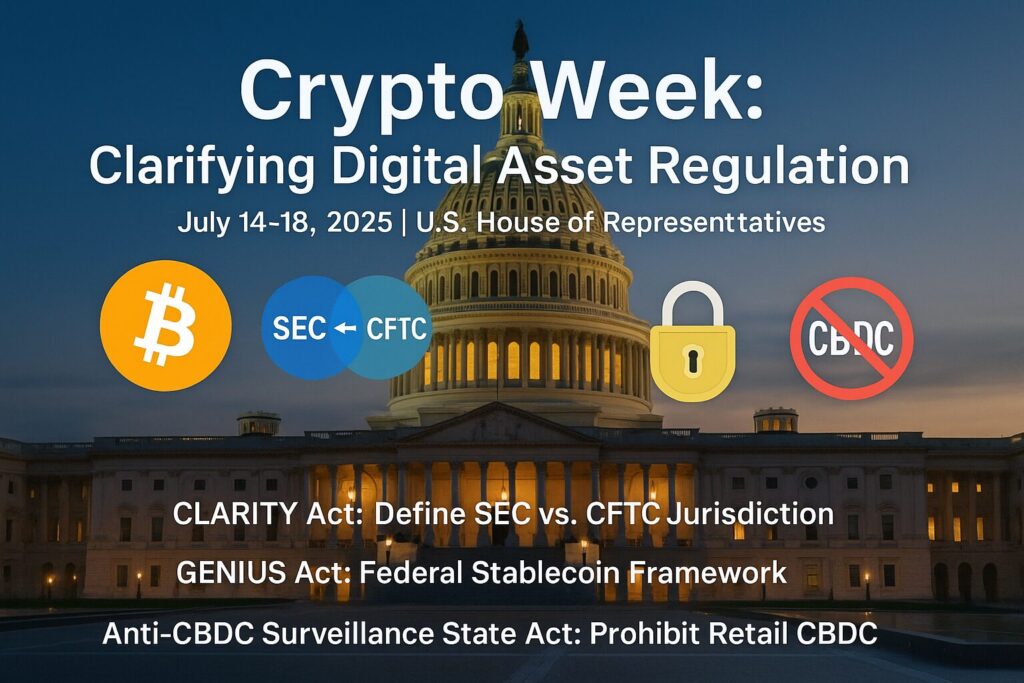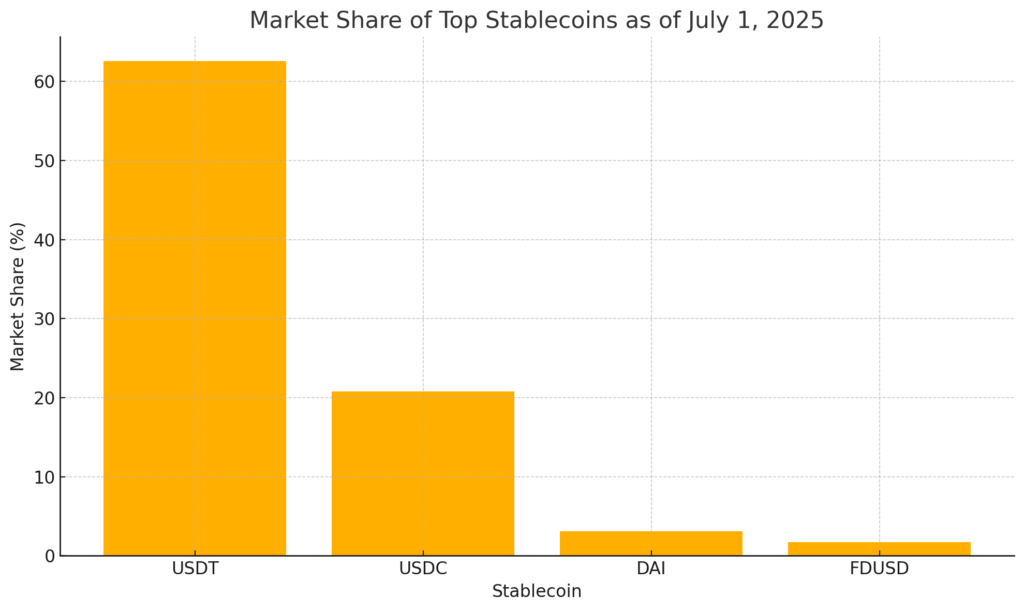
Main Points:
- The House of Representatives designates July 14–18, 2025 as “Crypto Week” to debate three pivotal crypto bills
- CLARITY Act will delineate SEC vs. CFTC jurisdiction over tokens and trading venues
- GENIUS Act creates the first federal stablecoin framework with reserve, audit, and consumer safeguards
- Anti-CBDC Surveillance State Act prohibits the Fed from issuing a retail CBDC to individuals, protecting financial privacy
- Bipartisan momentum reflects growing recognition of crypto’s economic significance and need for legal certainty
- Implications include reduced regulatory uncertainty, more institutional stablecoin adoption, and stronger privacy protections
Introduction
On July 7, 2025, U.S. House leadership announced that the week of July 14 would be dedicated to “Crypto Week,” during which lawmakers will debate three landmark bills designed to clarify and strengthen the regulatory framework for digital assets in the United States. This concentrated legislative push marks the culmination of years-long, bipartisan efforts to address the opaque status of cryptocurrencies under existing securities and commodities laws, while also crafting the first federal guidelines for stablecoins and safeguarding against potential government overreach via a central bank digital currency.
The CLARITY Act: Resolving Oversight Ambiguities
Subheading: Splitting Securities vs. Commodities Authority
The Digital Asset Market Clarity Act of 2025 (the CLARITY Act) was introduced in the House on May 29, 2025. It aims to resolve long-standing confusion over whether certain tokens are securities regulated by the SEC or commodities under the CFTC’s purview. Under this bill:
- The SEC and CFTC would conduct joint rulemakings within 180–360 days to define clear criteria for token classification and exchange operations.
- Digital commodities (e.g., Bitcoin) are explicitly excluded from being presumed securities, and vice versa.
- Alternative trading systems (ATS) and broker-dealers notice-registered with one agency can operate under the other’s oversight without duplicative registration burdens.
- A memorandum of understanding between the SEC and CFTC would ensure non-duplication in enforcement and supervision.
By streamlining the classification process and delineating responsibilities, the CLARITY Act promises to eliminate the regulatory uncertainty that has hampered crypto businesses and investors for years.
The GENIUS Act: First Federal Stablecoin Framework
Subheading: Safeguarding Dollar-Pegged Digital Assets
On June 17, 2025, the Senate passed the Guiding and Establishing National Innovation for U.S. Stablecoins Act (GENIUS Act) by a 68–30 vote. This landmark legislation establishes the first comprehensive federal framework for payment stablecoins, focusing on:
- Permitted Issuers: Only federally or state-regulated financial institutions may issue stablecoins, with state-chartered issuers capped at $10 billion before needing a federal charter.
- Reserve Requirements: Issuers must back every token 1:1 with high-quality liquid assets, such as cash or short-term U.S. Treasuries.
- Transparency & Audits: Monthly reserve disclosures certified by a public accounting firm and annual PCAOB-registered audits are required.
- Consumer Protections: Stablecoin holders are prioritized over general creditors in an issuer bankruptcy event, and interest payments on stablecoins are prohibited to avoid shadow-banking risks.
- AML/KYC Compliance: Full compliance with Bank Secrecy Act requirements, including sanctions screening and identity verification.
- Technical Controls: Issuers must implement the ability to freeze or seize assets under lawful court orders.
With stablecoins now accounting for over $250 billion in market value, this framework aims to bolster consumer confidence and encourage institutional adoption, while mitigating systemic and illicit-finance risks.
Anti-CBDC Surveillance State Act: Protecting Financial Privacy
Subheading: Barring Fed-Issued Retail CBDC
Also on the agenda is the Anti-CBDC Surveillance State Act, introduced by Sen. Ted Cruz and passed by the House in May 2024. This bill amends the Federal Reserve Act to:
- Prohibit Reserve Banks from offering accounts, products, or services directly to individuals.
- Bar both direct and indirect issuance of any central bank digital currency to retail users.
- Forbid the use of a CBDC for monetary policy operations by the Fed’s Board of Governors or the FOMC.
- Ensure that open, permissionless, and private digital currencies (e.g., Bitcoin) remain unaffected.
This act addresses concerns that a government-issued digital dollar could become a tool for surveillance—comparable to systems used by other regimes—and protects individual financial autonomy.
Implications for Investors and Blockchain Applications
Subheading: Toward Greater Certainty and Innovation
The convergence of these three bills during Crypto Week represents a watershed moment for the U.S. crypto industry. Key implications include:
- Regulatory Certainty: Clear jurisdiction and definitions under the CLARITY Act reduce legal risks for token issuers and trading platforms.
- Stablecoin Growth: With a federal framework, institutions—including banks, payment networks, and major corporates—can integrate stablecoins into payments and liquidity management with confidence.
- Privacy Safeguards: The Anti-CBDC Act allays fears of digital-cash surveillance, potentially encouraging broader crypto adoption among privacy-conscious users.
- Market Dynamics: Stablecoins dominate daily crypto flows, with USDT holding 62.54% of the market and USDC 20.75% as of July 1, 2025.
Below is a visualization of the current stablecoin market share:
Chart: Market Share of Top Stablecoins

(The chart above illustrates how Tether’s USDT, with 62.54% market share, leads stablecoins, followed by USDC at 20.75%, DAI at 3.11%, and FDUSD at 1.70%.)
These figures underscore why Congress views stablecoin regulation as critical: they’re integral to crypto trading, DeFi protocols, and cross-border payments.
Conclusion
As Crypto Week unfolds, the U.S. will take decisive steps toward a transparent, pragmatic regulatory environment for digital assets. The CLARITY Act clarifies agency roles and token status, the GENIUS Act establishes a robust framework for dollars-backed tokens, and the Anti-CBDC Surveillance State Act preserves individual privacy against potential government digital-currency overreach. Together, these measures promise to reduce uncertainty, spur institutional and consumer adoption, and cement blockchain’s practical role in finance and commerce—paving the way for the next wave of crypto innovation in America.

